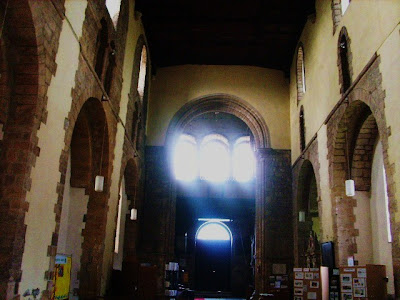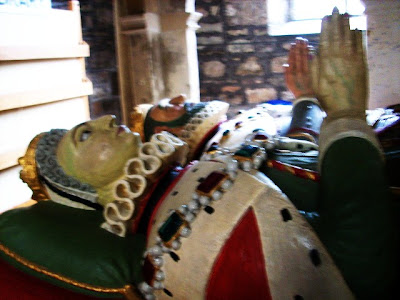





__________________________________________________________
Later Middle Ages-Effect of the Wars with France
As with many Benedictine Priories, and priories, the nave of the church was always used by the townspeople as their parish church and the Parish Priest had is own room in the priory, and was treated as one of the monks. During the 12th and 13th centuries, these were sent from the Abbey at Cormeilles, although I understand some local men were recruited as novices.
R.C.Shoesmith, who headed the excavations at the Priory in 1973-74 said that it is doubtful that the number of Benedictines at Chepstow ever went above 12 monks (the number of the Apostles) and a Prior. The problem lay in the difficulties between France and England in the Middle Ages and the frequent wars.After the loss of the French territories y King John in 1204, relationships between the Norman French abbeys became difficult , the number decreased. In 13790 there were only four monks and the prior left.
Another Problem-Taxation
y the mid 13th century French or 'alien' priories and monasteries were eing taxed y oth the Papacy and also the Throne, which made these small priories very short of money. St Peters was falling down and needed to be rebuilt, which was a priority by the 15th century. In 1291 Chepstow/Striguil Priory had an estate of 126 hectares (311 and a half acres) with a value of £35 .19s.11d everything included.
The Black Death
The Priory and townspeople of Chepstow all suffered from the viscious swathe of the Black Death. Rents were non-existent as people died, rents were not forthcoming and monks themselves fell victim to the plague as they went about their duties trying to administrate and care for the sick. Financially, therefore, it became weakened, as did so many other monks in similar places.
Edward I
Edward I seized the lands and rents of the alien priories, and appointed commissioners to collect the revenue and provide some maintenance for the foreign monks. Also in certain cases, the foreign monks were kept within their priory under a sort of house arrent.During the Hundred Years' War there were several orders given to seize the Priory no action was taken. In Edwards time however, the the value of the revenue and rent was £45.6S.8D.between 1360 and 1369 the taxes went back to normal but when war broke out again, things got worse. None of this did anything for the prosperity of the Priory as money was salted away everywhere and in 1387 until the Prior paid a fine for custody incurred since the egining of the war.
1396-1388 No Prior or Monks-Parish Priest in reseidence
In 1398, the Abot and monks of Cormeilles granted it to Sir Benedict Cely on several conditions which included the maintenance of three monks from Cormeilles at Chepstow.In 1399, Parliament appreiated that due to the expulsion of priors and misconduct of some commissioners at the various alien priories, the buildings had become broken down and granting hopsitality to visitors and giving alms to the poor had had to cease, as the monks themselves were very poor.To change this, English men were allowed to enter as novices again and, in the case of Chepstow, the Priory was returned to Simon of Bristol (descendent of Roger de Bretuil-son of FitzOsbern) in 1400, provided he paid the yearly fee to the Abbey of Cormeilles (apport)to the King.
Further Financial Trouble
But the temporary respite was not enough.In 1414, the Priory was attached to the English Benedictines at Bermondsey Abbey, in whose care it remained. With England and Normandy rapidly going their separate way, this was a sensible arrangement and for the rest of Catholic life at the Abbey, it remained with Bermondsey.The Priory lands themselves if you take the road to the Left of the Priory Car Park , extended straight up from the priory to the town Wall, which I imagine is now the main road , then extending southwards to the river, up to the bend following on from the road where the car park is, up to the end and down to the river. There was arable land, an orchard , sheep and cows, also rents from various town houses.Nevertheless, the Priory struggled on financially. The monks also served the Chapelwithin the castle,where the Earls of Worcester had their residence. The Earl and Countess' effigy has remained undisturbed in the Priory Church in spite of the efforts of the people sent by Edward's Regent and Elizabeth as well as Cromwell.It is very interesting to see them in their colour form.
 __________________________________________________________
__________________________________________________________Henry VIII and the destruction of the monasteries
Henry VIII wanted a divorce from his wife of 35 years, the daughter of the King and !Queen of Spain , known now as Blessed Catherine of England.Cast off after a succession of mistresses, including the sister of Anne Boleyn, he cast off Catherine ostensibly because he claimed he could not marry his brother's wife because otherwise 'Children they shall have none'. This was clearly not true as they had a child, Mary, also declared illegitimate. The Queen argued desperately with parliament and suffered a whole series of Cranmer's sermons but was banished , and there were reports she was later poisoned, though I have no source for this claim, told to me bya historian. Mary bravely resisted all attempts to change her faith. Henry then went through a form of marriage with Anne Boleyn after the Pope had refused to grant an annulment-as he clearly had no authority to do. Henry had also asked to be cleared of 'affinity' with Mary Boleyn (he had had relations with her, and she became pregnant and was also cast off both by Anne and Henry) The result of this was that Henry, strapped for cash seized all church lands in England, destroyed the monasteries and banished the monks. Very few got pensions and with a swathe the social services they rendered to those around them, such as the 'dole' disappeared. The issue of the care of the poor was never settled, even with the Elizabethan poor laws and the Victorian solution was the workhouse.The King made himself Head of the Church, but never found real happiness and there is a report, that on his deathbed he prayed to our Lady of Walsingham for forgiveness.More of all this later. For some of her banishment, Catherine was at Sudeley and there embroidered the famous tablecloth, for Winchcombe Priory (now St Peter's Parish Church)
Chepstow and the Reormation
Henry sent around agents 'visiting' the various Abbeys Monasteries and Priories and often these agents themselves were able to buy the poorer properties at a knock down price. The Abbey houses were often rebuilt and converted for the large houses of the aristocracy and they later were to enclose the lands and banish the peasants, whose houses cluttered the land.There also followedterrible laws against Catholics.The Priory at Chepstow was destroyed in 1536. The monastic end was destroyed, leaving the nave as the parish church with the tower. The Priory buildings (accommodation area)were destroyed 'which the said Lord King will have ordered to be demolished and removed'. The demolition took place, because as the expert Shoesmith tells us that there was a report in the early 17th century, the greater part of the prory had been demolished, with the remained converted to a parish church.(1607)
The Priory was leased to the Goldsmith of London Morgan Wolfe, citizen of London, but not the church and priory itself.
The Norman Church had been designed on a grand scale, a choir, choir aisles, a crossing with transepts and a central tower, with a long nave and North and south aisles.In the Victorian times, the monastic end had been rebuilt as a high altar . 1841, the nave aisles were removed, and the Eastern End , crossing and transepts will be rebuilt.Shoesmith says the size of the windows of the tower 'giving some slight impression of the aspirations of the Norman founder and the builders.
On my visit, I was amazed at the size of the chuch and its antiquity,and feel it is one of Wales best kept secrets. The Priory is open most days for viewing and there are many artefacs, like the Millenium tapestry above. Also golden angels. The piscina of the original Abbey church still remains, although the sink has been blocked up, ut there is an element of huge grandeur. The Church is well used by the people of Chepstow and a Mass was recently held there by a French group of pilgrims to Tintern Abbey. Concerts have also taken place there. Everyone in the area should visit this wonderful Abbey Church and the kindly wardens, who keep it open for prayer and viewing by anyone.
Later this week I will post some pictures of the Gloucester Church of St Mary de Crypt, which although Old English in Style, has a Priory building similar to many priories of the period, and whose tower remains in situ in the middle. St Mary de Crypt has recently had a rebuilt stone pulpitum.






















































































No comments:
Post a Comment